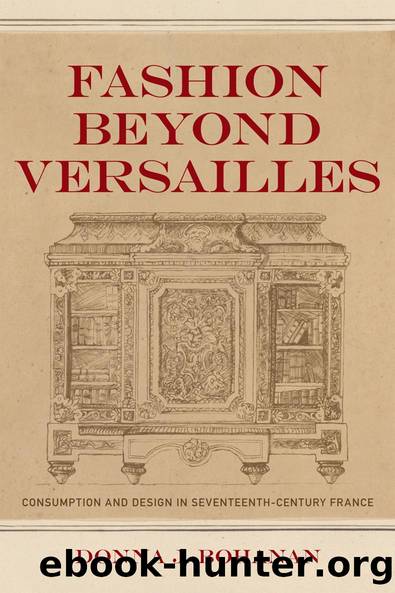Fashion beyond Versailles by Donna J. Bohanan

Author:Donna J. Bohanan [Bohanan, Donna J.]
Language: eng
Format: epub
Tags: History, Europe, Western, Modern, 17th Century, France
ISBN: 9780807145234
Google: wjdhAaSy1YkC
Publisher: LSU Press
Published: 2012-06-04T16:02:20+00:00
FIGURE 4.2. LOUIS XIVâSTYLE PEDIMENT MIRROR
If the mainsprings of fashion were novelty and innovation, consumers took pleasure in the acquisition of goods that were new, and, in the words of Maxine Berg, the ânovelty represented by fashion in the seventeenth and eighteenth century was a challenge to the status quo and an unchanging social order. It was a choice of an individualist over a hierarchical lifestyle: changes and trends would allow private individuals at least a minimal margin of freedom, choice, and autonomy in matters of taste.â33 Among the goods that sustained the consumer revolution were items of a novel nature that did not conform to traditional ideas of luxury, items whose practicality and convenience seemed to place them ambiguously between luxury and necessity. Chaises de commodité, daybeds, and sofas were all the products of design innovation and gratified the demand for furnishings that promoted bodily comfort and accommodated the desire for greater privacy. They were not used in private spaces exclusively. In some households they were objects on display; in others they were part of the allure of interior spaces. Their novelty promoted their appeal with provincial consumers.
Early modern ideas about political economy contrasted luxury with its polar opposite, necessity. In the eighteenth century, however, comfort was âincreasingly applied to a middle ground between necessity and luxury.â34 Moreover, the political economy of the period âmade it possible for both luxury and necessity to become morally neutral terms.â35 Thus, the luxury debate of the eighteenth century assumed a different tone, less concerned with moral corruption and focused more on incentives to consume. Convenience played a significant role in shifting the debate.36 Dena Goodman maintains, âAs the number of objects in circulation increased along with their diffusion through society, the words âluxuryâ and ânecessityâ lost both meaning and power.â37 The European consumer revolution pertained not only to traditional luxury goods; it included in England a range of goods with âvalues of usefulness, civility, and ingenuity.â38 I argue, based on the inventories presented herein, that the same was true of France, where remote parts of the realm included, there was a growing awareness of the body and its relationship to the physical environment on the part of craftsmen and consumers.
Writing about the Dutch in the Golden Age, Jan de Vries categorizes these changing ideas as the Old Luxury, an effort to produce or reproduce grandeur and refinement, and the New Luxury, the purpose of which was comfort and enjoyment and which was directed toward the home and specifically its interior.39 The New Luxury was not about ostentation and opulence; it was about access to objects that had been designed to advance comfort and whose positioning within the household often obscured them from public view.
Many of the changes associated with the New Luxury and the rise of privacy have been more closely identified with England rather than France. England has long been connected with ideas of comfort and a specific cult of domesticity. In his magisterial study of Englishness, Paul Langford writes of the ways in which the English came to value comfort, hearth, and home.
Download
This site does not store any files on its server. We only index and link to content provided by other sites. Please contact the content providers to delete copyright contents if any and email us, we'll remove relevant links or contents immediately.
Women and Jewish Marriage Negotiations in Early Modern Italy by Howard Tzvi Adelman(396)
Warrior King by Wilbur Smith(350)
18 real-life stories of serial killers and murderers with solved and unsolved killings from the USA, UK, Europe, and beyond. by Ben Oakley(275)
Who's Who in the Zulu War, 1879: The British by Adrian Greaves Ian Knight(263)
Violence and Emotions in Early Modern Europe by Susan Broomhall;Sarah Finn;(263)
The Battle of Austerlitz by 50minutes(260)
The American Crisis by Unknown(256)
The Seeker by S. G. MacLean(216)
Youth, Heroism and War Propaganda: Britain and the Young Maritime Hero, 1745â1820 by D. A. B. Ronald(215)
The Origins of French Absolutism, 1598-1661 by Alan James(208)
The Dutch East India Company and British East India Company: The History and Legacy of the Worldâs Most Famous Colonial Trade Companies by Charles River Editors(206)
The Traitor of Colditz by Robert Verkaik(192)
Invisible Worlds by Peter Marshall(192)
A Genius for Confusion by Richard M. Fried(191)
The Thirty Years War â Complete by Friedrich Schiller(187)
The Slave Trade in Africa by Simon Webb;(186)
Fires of Faith by Catholic England under Mary Tudor(186)
The Opium Wars: Exploring the Addiction of Empires from Beginning to End by Ramos Adrian & Compacted History(185)
Interest and Connection in the Eighteenth Century by Jacob Sider Jost(183)
